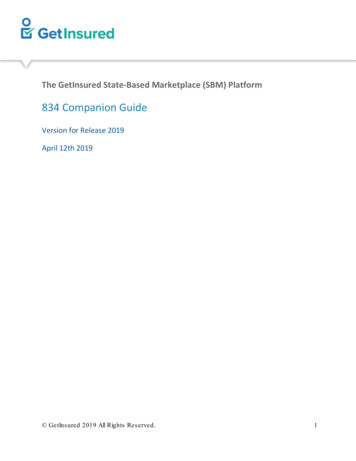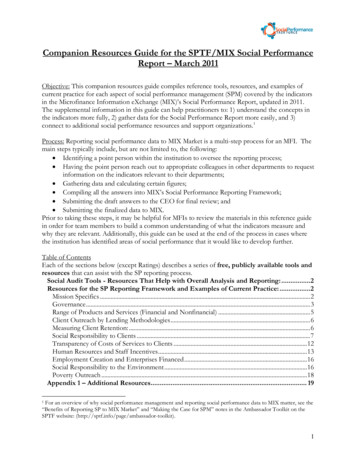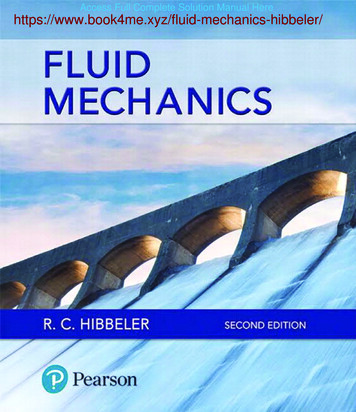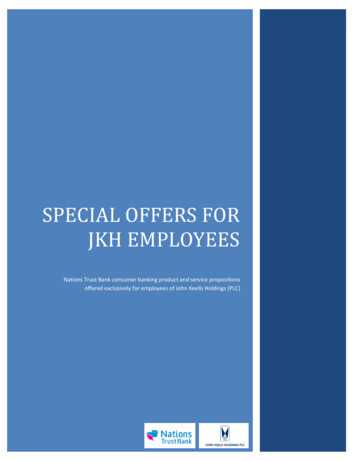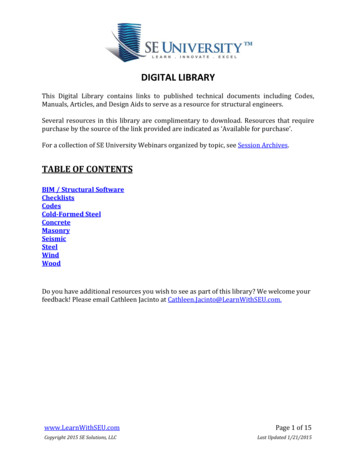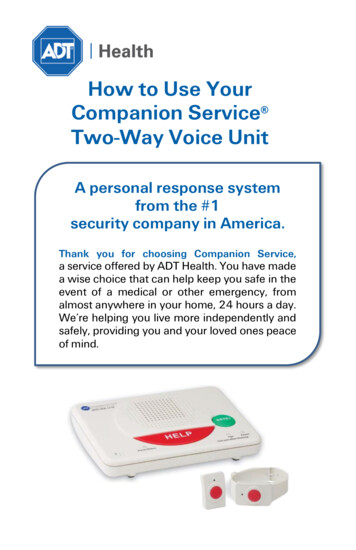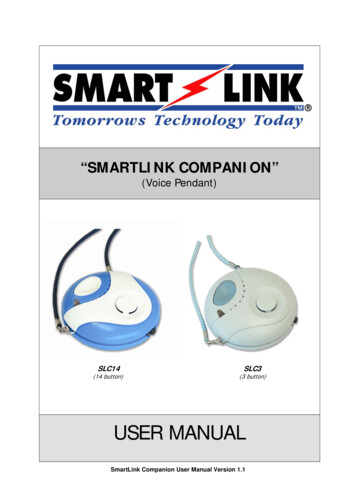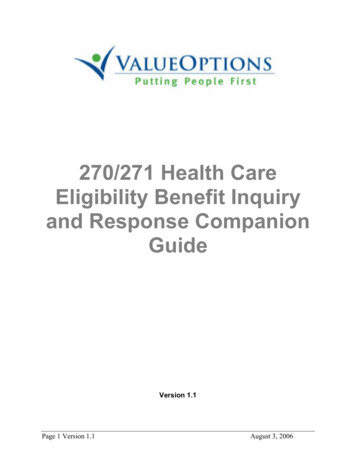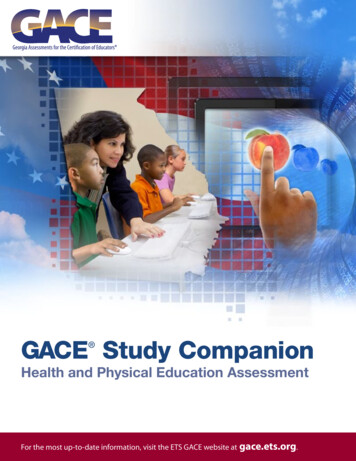
Transcription
GACE Study Companion Health and Physical Education AssessmentFor the most up-to-date information, visit the ETS GACE website at gace.ets.org.
Last Updated: June 2018Copyright 2018 by Educational Testing Service. All rights reserved. ETS is a registeredtrademark of Educational Testing Service (ETS). Georgia Assessments for the Certification ofEducators, GACE, and the GACE logo are registered trademarks of the Georgia ProfessionalStandards Commission (GaPSC). All other trademarks are property of their respective owners.This publication has been produced for the GaPSC by ETS. ETS is under contract to theGaPSC to administer the Georgia Assessments for the Certification of Educators. TheGeorgia Assessments for the Certification of Educators are administered under the authorityof the GaPSC; regulations and standards governing the program are subject to change withoutnotice at the discretion of the GaPSC. The GaPSC and ETS are committed to preventingdiscrimination on the basis of race, color, national origin, sex, religion, age, or disability in theadministration of the testing program or the provision of related services.
Table of ContentsAbout the Assessment . 4Content Specifications . 5Test I Subareas . 6Test I Objectives . 6Subarea I: Mental and Emotional Health/Professional Issues . 6Subarea II: Personal Health and Wellness, Sexual Health, and Nutrition . 7Subarea III: Safety and Injury Prevention, and Alcohol, Tobacco, and other Drugs . 8Test II Subareas .10Test II Objectives .10Subarea I: Basic Sciences of Physical Education.10Subarea II: Motor Learning and Motor Development .11Subarea III: Sports, Activities, and Fitness .11Subarea IV: Instructional Principles and Professionalism in Physical Education .12Practice Questions .14Answer Key and Rationales .35Preparation Resources .55Guide to Taking a GACE Computer-delivered Assessment .55Reducing Test Anxiety.55Study Tips: Preparing for a GACE Assessment .55Journals.55Other Resources .55Online Resources .56Note: After clicking on a link, right click and select “Previous View” to go back to original text.GACE Health and Physical Education Assessment Study Companion3
About the AssessmentAssessment NameHealth and Physical EducationGrade LevelP–12Test CodeTest I: 115Test II: 116Combined Test I and Test II: 615Testing TimeTest I: 2 hours and 10 minutesTest II: 2 hours and 10 minutesCombined Test I and Test II: 4 hours and20 minutesTest DurationTest I: 2.5 hoursTest II: 2.5 hoursCombined Test I and Test II: 5 hoursTest FormatComputer deliveredNumber of Selected-response QuestionsTest I: 100Test II: 100Combined Test I and Test II: 200Question FormatThe test consists of a variety of short-answerquestions such as selected-responsequestions, where you select one answerchoice or multiple answer choices (dependingon what the question asks for), questionswhere you enter your answer in a text box,and other types of questions. You can reviewthe possible question types in the Guide toTaking a GACE Computer-delivered Test.Number of Constructed-response QuestionsTest I: 0Test II: 0Combined Test I and Test II: 0The GACE Health and Physical Education assessment is designed to measure the professionalknowledge of prospective teachers of Health and Physical Education in the state of Georgia.The fifth edition of the Diagnostic and Statistical Manual of Mental Disorders (DSM-5) waspublished in May 2013 with revisions to the criteria for the diagnosis and classifications ofmental disorders. In the interest of fairness, and to allow time for educator preparation programsto integrate such changes into their curricula, test materials for this assessment will continue toreference the terminology, criteria, and classifications referred to in the fourth edition of theDiagnostic and Statistical Manual of Mental Disorders (DSM-IV-TR) until further notice.Note: After clicking on a link, right click and select “Previous View” to go back to original text.GACE Health and Physical Education Assessment Study Companion4
This assessment includes two tests. You may take either test individually or the full assessmentin a single session. The testing time is the amount of time you will have to answer the questionson the test. Test duration includes time for tutorials and directional screens that may be includedin the test. The questions in this assessment assess both basic knowledge across content areasand the ability to apply principles.The total number of questions that are scored is typically smaller than the total number ofquestions on the test. Most tests that contain selected-response questions also includeembedded pretest questions, which are not used in calculating your score. By including pretestquestions in the assessment, ETS is able to analyze actual test-taker performance on proposednew questions and determine whether they should be included in future versions of the test.Content SpecificationsEach test in this assessment is organized into content subareas. Each subarea is furtherdefined by a set of objectives and their knowledge statements. The objectives broadly define what an entry-level educator in this field in Georgia publicschools should know and be able to do. The knowledge statements describe in greater detail the knowledge and skills eligible fortesting. Some tests also include content material at the evidence level. This content serves asdescriptors of what each knowledge statement encompasses.See a breakdown of the subareas and objectives for the tests in this assessment on thefollowing pages.Note: After clicking on a link, right click and select “Previous View” to go back to original text.GACE Health and Physical Education Assessment Study Companion5
Test I SubareasSubareaApprox. Percentageof TestI. Mental and Emotional Health/Professional Issues25%II. Personal Health and Wellness, Sexual Health, and Nutrition40%III. Safety and Injury Prevention, and Alcohol, Tobacco, andOther Drugs35%Test I ObjectivesSubarea I: Mental and Emotional Health/Professional IssuesObjective 1: Understands the issues related to mental and emotional healthThe beginning Health and Physical Education teacher:A. Understands psychosocial development/emotional well-beingB. Knows the causes/consequences of mental/emotional health issuesC. Knows the consequences of risk-taking behaviorsD. Understands stress management skillsE. Knows how to identify factors that promote positive self-concept and self-esteemF. Understands factors affecting healthy and unhealthy relationshipsG. Understands strategies for coping with changes in familiesH. Understands the concepts of interpersonal communicationI.Understands skills promoting healthy interactionsJ. Understands the functions of various types of interpersonal relationshipsK. Understands group dynamicsL. Knows the social/cultural influences on communicationM. Understands factors affecting decisions about datingN. Understands the causes of conflict among youthO. Knows the signs, symptoms, causes, and effects of self-destructive behaviorNote: After clicking on a link, right click and select “Previous View” to go back to original text.GACE Health and Physical Education Assessment Study Companion6
Objective 2: Understands the professional issues related to health educationThe beginning Health and Physical Education teacher:A. Knows the opportunities available for health education advocacyB. Understands how to implement curricular and extracurricular programsC. Understands the role of health educator as a liaisonD. Understands the factors influencing the content of health educationE. Knows how to locate and use valid sources of health informationF. Knows how to recognize and use effective peer leadership intervention, resistance, andrefusal skillsG. Understands goal-setting and decision makingH. Understands risk factors and protective factors related to personal health and safetypracticesI.Knows the components of the Whole School, Whole Community, Whole Child (WSCC)model, formerly the coordinated school health (CSH) approachSubarea II: Personal Health and Wellness, Sexual Health, and NutritionObjective 1: Understands the principles of personal health and wellnessThe beginning Health and Physical Education teacher:A. Knows the concepts of personal hygieneB. Understands the concepts of anatomy and physiology and body systeminterrelationshipsC. Knows the patterns and stages of physical, cognitive, social, and emotional growth anddevelopmentD. Understands various factors that affect physical, cognitive, social, and emotional growthand developmentE. Knows how to describe disease etiology and prevention/treatmentF. Understands the difference between communicable and non-communicable diseasesG. Understands the role of the body’s immune systemNote: After clicking on a link, right click and select “Previous View” to go back to original text.GACE Health and Physical Education Assessment Study Companion7
Objective 2: Understands the issues related to sexual healthThe beginning Health and Physical Education teacher:A. Knows the anatomy/physiology of the human reproductive systemB. Understands the decision-making process and considerations related to planninga familyC. Knows the stages that occur during pregnancy and childbirthD. Knows the factors that influence sexual decisionsE. Knows the causes of HIV/AIDSF. Knows the methods for preventing pregnancy, STDs, and HIV/AIDSObjective 3: Understands the principles of nutritionThe beginning Health and Physical Education teacher:A. Knows how to identify the functions and sources of nutrientsB. Understands the components of My Plate and Dietary Guidelines for AmericansC. Knows the components of a balanced dietD. Understands principles for planning nutritious mealsE. Understands factors affecting food choices and eating habitsF. Knows dietary disorders and health issuesG. Knows how to evaluate diets relative to personal needsSubarea III: Safety and Injury Prevention, and Alcohol, Tobacco, and other DrugsObjective 1: Understands the issues related to safety and injury preventionThe beginning Health and Physical Education teacher:A. Understands weather emergenciesB. Knows methods for promoting self care, safe behaviors, and injury preventionC. Knows appropriate ways to respond to accidentsD. Understands threats to personal safetyE. Knows the legislation, agencies, and policies that support community healthF. Knows the characteristics of safe and unsafe places for play, travel, and recreationG. Understands the causes, consequences, and prevention of different types of abuse andviolenceH. Understands common causes and effects of accidentsNote: After clicking on a link, right click and select “Previous View” to go back to original text.GACE Health and Physical Education Assessment Study Companion8
Objective 2: Understands the issues related to the use of alcohol, tobacco, and other drugsThe beginning Health and Physical Education teacher:A. Understands the effects of substance use and abuseB. Knows the appropriate uses of medicinesC. Knows the classifications of alcohol, tobacco, and other drugsD. Understands the factors contributing to health risks associated with the use of alcohol,tobacco, and other drugsE. Knows how the use of alcohol, tobacco, and other drugs affect personal goalsF. Understands how adolescent and teen drug use contributes to accidents, crime, suicide,mortality, and sexual activityG. Understands that alcohol, tobacco, and drug dependencies are treatable diseasesH. Knows how to analyze alcohol, tobacco, and drug advertisementsNote: After clicking on a link, right click and select “Previous View” to go back to original text.GACE Health and Physical Education Assessment Study Companion9
Test II SubareasSubareaApprox. Percentageof TestI. Basic Sciences of Physical Education20%II. Motor Learning and Motor Development15%III. Sports, Activities, and Fitness30%IV. Instructional Principles and Professionalism in PhysicalEducation35%Test II ObjectivesSubarea I: Basic Sciences of Physical EducationObjective 1: Understands how the applied sciences are related to physical educationThe beginning Health and Physical Education teacher:A. Understands biomechanics and kinesiologyB. Understands exercise physiology and fitnessObjective 2: Understands the principles of anatomy and physiology as related to physicaleducationThe beginning Health and Physical Education teacher:A. Understands anatomy and physiologyB. Understands the components of flexibilityC. Knows the major muscle groupsNote: After clicking on a link, right click and select “Previous View” to go back to original text.GACE Health and Physical Education Assessment Study Companion10
Subarea II: Motor Learning and Motor DevelopmentObjective 1: Understands the principles of motor learningThe beginning Health and Physical Education teacher:A. Understands principles, stages, sequences, and characteristics of motor developmentand learningB. Understands factors influencing motor development and learningC. Understands motor-learning conceptsD. Knows instructional prompts and cues for providing motor performance feedbackE. Understands skill themes and ways to promote movement conceptsObjective 2: Understands the principles of motor developmentThe beginning Health and Physical Education teacher:A. Knows how to apply movement conceptsB. Understands movement principles and their applicationC. Knows critical elements of movement patternsD. Understands how to combine locomotor, nonlocomotor, and manipulative skillsand patternsE. Knows how to select developmentally appropriate techniques, skills, sequences,equipment, and materials for complex rhythmic, aerobic, and dance activitiesSubarea III: Sports, Activities, and FitnessObjective 1: Understands the principles of individual, dual, team, and lifetime sports or activitiesThe beginning Health and Physical Education teacher:A. Knows the skills, rules, strategies, sequences, and performance assessment techniquesfor individual, dual, team, and lifetime sports, dance, and other activitiesB. Understands critical elements essential to competent performance in individual, dual,and lifetime sportsC. Understands critical elements essential to competent performance in team sportsD. Understands critical elements of outdoor, adventure, and cooperative activitiesE. Understands critical elements essential to competent performance in creative movementand danceNote: After clicking on a link, right click and select “Previous View” to go back to original text.GACE Health and Physical Education Assessment Study Companion11
Objective 2: Understands fitness as it relates to training, fitness plans, sports, and activitiesThe beginning Health and Physical Education teacher:A. Understands principles of training and conditioningB. Knows principles and techniques for designing a fitness planC. Knows the effect of participation in sports and activitiesD. Knows the appropriate etiquette, interactions, care of equipment, safety practices, andenvironmental considerationsSubarea IV: Instructional Principles and Professionalism in Physical EducationObjective 1: Understands management and motivation as it relates to physical educationThe beginning Health and Physical Education teacher:A. Knows the principles of classroom managementB. Understands the psychological and social factors that affect individual and grouplearningC. Knows how to manage resourcesD. Knows how to motivate studentsE. Knows how to promote positive relationshipsF. Knows how to use rules and routines to create a safe and effective learning environmentG. Knows how to promote self-management skillsObjective 2: Understands communication and collaboration as related to physical educationThe beginning Health and Physical Education teacher:A. Understands effective verbal and nonverbal communicationB. Knows how to provide appropriate instructional feedbackC. Knows how to deliver effective demonstrations and explanationsD. Knows how to integrate knowledge and skills from multiple subject areas in physicaleducationE. Knows how to promote opportunities to be physically activeNote: After clicking on a link, right click and select “Previous View” to go back to original text.GACE Health and Physical Education Assessment Study Companion12
Objective 3: Understands the principles involved in physical education planning and instructionThe beginning Health and Physical Education teacher:A. Knows how to achieve and maintain a health-enhancing level of fitness in a physicaleducation programB. Knows how to design and sequence activities for skill developmentC. Knows how to design and sequence activities for health and skill-related fitnessD. Knows how to integrate information technologyE. Know how to use technology in physical educationObjective 4: Understands the principles of student assessment, adapted physical education,and professionalismThe beginning Health and Physical Education teacher:A. Knows how to plan and adapt instruction for special need studentsB. Knows how to assess individuals with disabilitiesC. Knows how to gather and assess data for skill performanceD. Knows the goals and purposes of the various fitness assessmentsE. Knows how to demonstrate and support the concept that all students can becomephysically educated individualsF. Knows the historical, philosophical, social, and legal issues in physical educationG. Understands liability and legal considerations pertaining to use of equipment, classorganization, supervision, program selection, gender, and disabilityH. Understands the factors affecting participation in physical activityNote: After clicking on a link, right click and select “Previous View” to go back to original text.GACE Health and Physical Education Assessment Study Companion13
Practice QuestionsThe practice questions in this study companion are designed to familiarize you with the typesof questions you may see on the assessment. While they illustrate some of the formats andtypes of questions you will see on the test, your performance on these sample questions shouldnot be viewed as a predictor of your performance on the actual test. Fundamentally, the mostimportant component in ensuring your success is familiarity with the content that is covered onthe assessment.To respond to a practice question, choose one of the answer options listed. Be sure to readthe directions carefully to ensure that you know what is required for each question. You may findit helpful to time yourself to simulate actual testing conditions. A correct answer and a rationalefor each sample test question are in the section following the practice questions.Keep in mind that the test you take at an actual administration will have different questions,although the proportion of questions in each subarea will be approximately the same. Youshould not expect the percentage of questions you answer correctly in these practice questionsto be exactly the same as when you take the test at an actual administration, since numerousfactors affect a person’s performance in any given testing situation.Note: After clicking on a link, right click and select “Previous View” to go back to original text.GACE Health and Physical Education Assessment Study Companion14
Directions: Each of the questions or incomplete statements below is followed by suggestedanswers or completions. Select the best option or options in each case.1.Essential amino acids are best described as those amino acids that areA.B.C.D.required for protein synthesis but cannot be made by the body.naturally occurring substances that help fight infection.important components of carbohydrates, fats, and proteins.high-energy nutrients that promote growth and development.Answer and Rationale2.Which of the following students is most likely to lose weight safely?A.B.C.D.NameRobertJudyTimAliceDaily Intake (calories)3,0003,0002,0001,000Daily Expenditure (calories)3,0002,0002,8004,000Answer and Rationale3.Which of the following can be used most effectively to determine an individual’s bodyfat composition?A.B.C.D.Scales and a height-weight chartA skinfold caliperMeasurements of the circumference of the individual’s waist, hips, thighs, and armsHydrostatic weighingAnswer and RationaleNote: After clicking on a link, right click and select “Previous View” to go back to original text.GACE Health and Physical Education Assessment Study Companion15
4.The presence of the ozone layer in the upper atmosphere is important because itA.B.C.D.enhances the greenhouse effect.has led to sharp increases in skin cancers.absorbs harmful ultraviolet radiation.reduces acid rain and urban smog.Answer and Rationale5.Approval of AZT for use in treating AIDS came under the jurisdiction of which of thefollowing agencies?A.B.C.D.Federal Trade CommissionUnited States Consumer Product Safety CommissionState-level offices of consumer affairsUnited States Food and Drug AdministrationAnswer and Rationale6.Fetal alcohol syndrome is associated with which of the Developmental disabilitiesAnswer and RationaleNote: After clicking on a link, right click and select “Previous View” to go back to original text.GACE Health and Physical Education Assessment Study Companion16
7.Which of the following correctly describes the usual pathway of sperm through the femalereproductive tract to the site of fertilization?A.B.C.D.Vagina, cervix, fallopian tube, uterusVagina, uterus, fallopian tube, cervixVagina, cervix, uterus, fallopian tubeUrethra, vagina, fallopian tube, uterusAnswer and Rationale8.Amniocentesis is most often used toA.B.C.D.facilitate artificial insemination.measure immune-response capability in transplant recipients.determine the presence of certain disorders in the fetus.estimate the mother’s potential for maintaining a pregnancy to term.Answer and Rationale9.Compared to younger women, women over age 35 have an increased risk of giving birth tochildren with which of the following genetic disorders?A.B.C.D.Cystic fibrosisDown syndromeHemophiliaSickle-cell anemiaAnswer and RationaleNote: After clicking on a link, right click and select “Previous View” to go back to original text.GACE Health and Physical Education Assessment Study Companion17
10. The Whole School, Whole Community, Whole Child (WSCC) model, formerly thecoordinated school health (CSH) approach, includes which THREE of the following?A.B.C.D.Comprehensive school health educationPhysical education and physical activityNutrition environment and servicesHealth newslettersAnswer and Rationale11. A high school has had a series of incidents of sexual harassment in the hallways. One of thehealth education teachers assigns students to create posters in class encouraging positivepeer pressure to prevent sexual harassment. The teacher’s assignment is contributing tothe school’sA.B.C.D.healthy environment.health services.family and community involvement.counseling services.Answer and Rationale12. HIV may be transmitted from one individual to another in which of the following ways?Select all that apply.A.B.C.D.Through contact made during oral sexBy an infected mother feeding breast milk to an infantPerinatally from an infected mother to her fetusGenetically from parent to childAnswer and RationaleNote: After clicking on a link, right click and select “Previous View” to go back to original text.GACE Health and Physical Education Assessment Study Companion18
13. In which of the following activities can a teacher best observe students demonstratingrefusal skills?A.B.C.D.Having students interact outside of classHaving students role-playHaving students read from the textbookHaving students create a posterAnswer and Rationale14. When designing activities to address the different learning styles of students within theintegrated health classroom, the health teacher should consider the theory of multipleintelligences suggested byA.B.C.D.Howard GardnerJohn DeweyRobert MarzanoMadeline HunterAnswer and Rationale15. Which of the following neurotransmitters is affected by the antidepressant Prozac wer and RationaleNote: After clicking on a link, right click and select “Previous View” to go back to original text.GACE Health and Physical Education Assessment Study Companion19
16. Which of the following environmental problems is most lethal to people worldwide?A.B.C.D.Acid rainAir pollutionOzone depletionWater pollutionAnswer and Rationale17. According to the Centers for Disease Control and Prevention (CDC), which of the followingare among the top four causes of death for young people ages 15 to 24 in the United States?Select all that apply.A.B.C.D.SuicideMotor vehicle injuriesHomicideDiabetesAnswer and Rationale18. When planning goals for lessons in health class, which THREE of the following should theteacher be most concerned with?Select all that apply.A.B.C.D.How easily the material can be presented in classHow the information presented is relevant to the learnerWhat motivates enthusiasm for the subject in the learnerWhat types of learners make up the class populationAnswer and RationaleNote: After clicking on a link, right click and select “Previous View” to go back to original text.GACE Health and Physical Education Assessment Study Companion20
19. Which of the following best describes a formative evaluation?A.B.C.D.Documenting the feasibility of implementing a student exercise programDetermining the effectiveness of a school system’s HIV-prevention initiativeDocumenting the level of dissemination of a research-based curriculum within a stateMonitoring progress in completing plans for a tobacco-use prevention training eventAnswer and Rationale20. Hib is best described as a type ofA.B.C.D.bacteria.immune disorder.health information system.behavioral disorder.Answer and Rationale21. The affective domain of Bloom’s taxonomy includes which of the following typesof behavior?Select all that nswer and RationaleNote: After clicking on a link, right click and select “Previous View” to go back to original text.GACE Health and Physical Education Assessment Study Companion21
22. Which of the following can be obtained only with a prescription from a licensed physician?A.B.C.D.Vitamin supplementsBirth control pillsDiet pillsWeight training supplementsAnswer and Rationale23. Which THREE of the following are major components of the Whole School, WholeCommunity, Whole Child (WSCC) model, formerly the coordinated school health (CSH)approach?A.B.C.D.Employee wellnessComprehensive school health educationHealth insurance for studentsCommunity involvementAnswer and Rationale24. A negative energy balance of which of the following is required to lose one poundper week?A.B.C.D.4,500 calories3,500 calories2,500 calories1,500 caloriesAnswer and RationaleNote: After clicking on a link, right click and select “Previous View” to go back to original text.GACE Health and Physical Education Assessment Study Companion22
25. An increase in the risk of heart disease is associated with an increase in which THREE ofthe following?Select all that apply.A.B.C.D.Blood pressureSerum cholesterolLow-density lipoproteinHigh-density lipoproteinAnswer and Rationale26. Which of the following most accurately represents the number of extra calories a pregnantwoman should consume per day to prepare for a healthy birth?A.B.C.D.200 3001,000 1,2001,500 2,000Double her normal caloric intakeAnswer and Rationale27. Which of the following is a respiratory condition characterized by inflammation, excessivemucus production, and the constriction of the bronchi?A.B.C.D.Allergic rhinitisEmphysemaSleep apneaAsthmaAnswer and RationaleNote: After clicking on a link, right click and select “Previous View” to go back to original text.GACE Health and Physical Education Assessment Study Companion23
28. Some people feel an improvement in their health after taking a remedy that has no provenscientific effect on health status. This is an example of which of the following?A.B.C.D.A med
H. Understands risk factors and protective factors related to personal health and safety practices I. Knows the components of the Whole School, Whole Community, Whole Child (WSCC) model, formerly the coordinated school health (CSH) approach Subarea II: Personal

